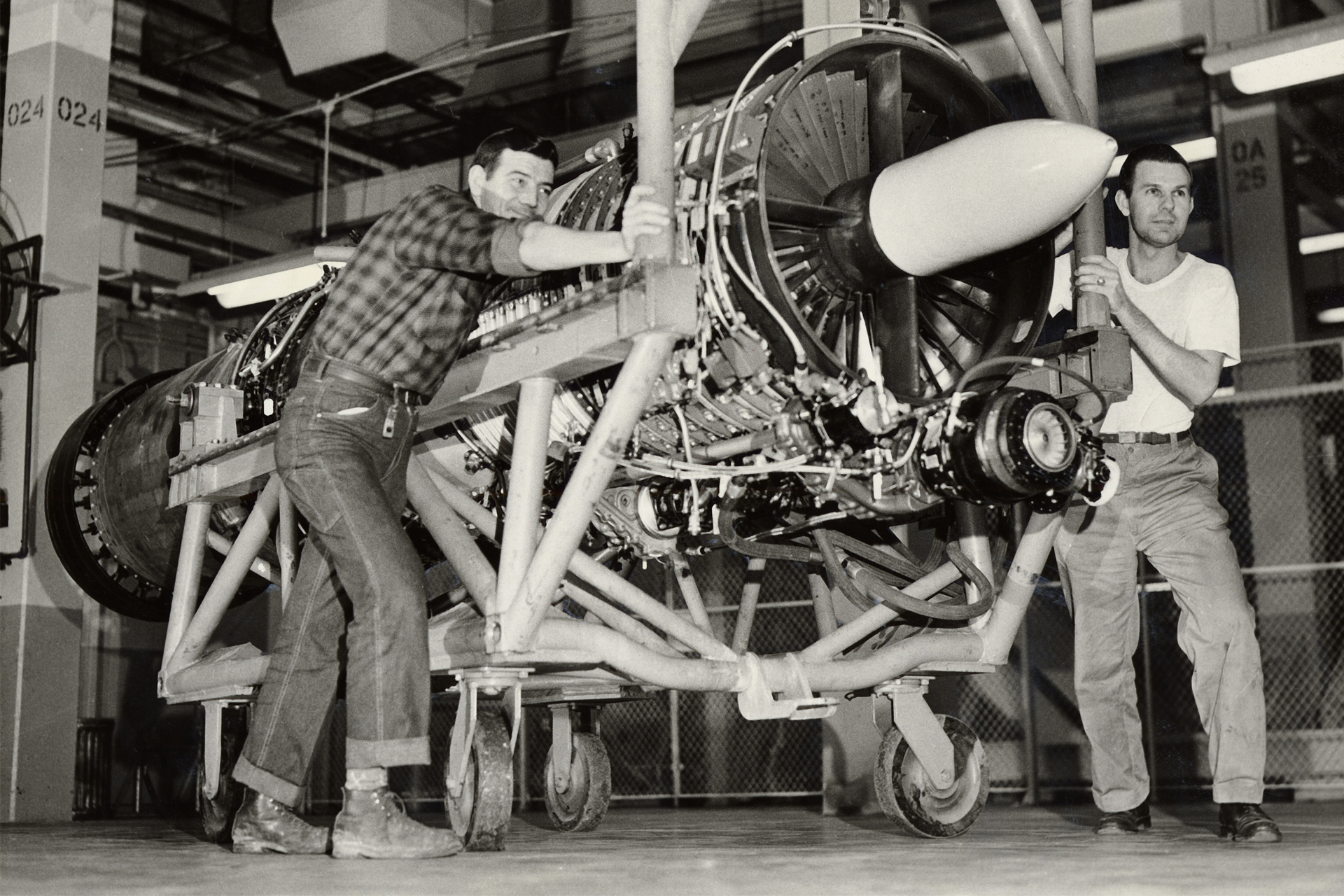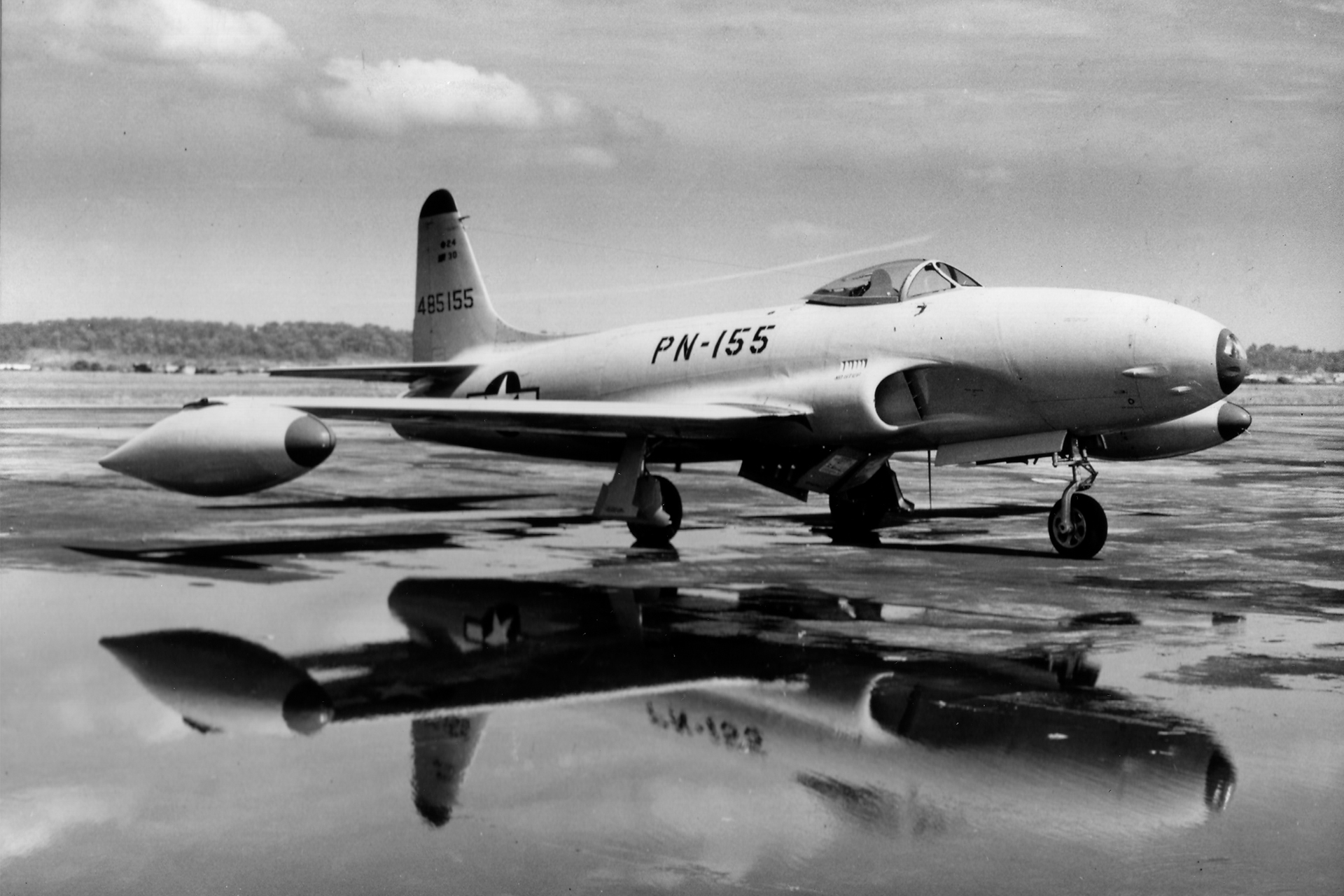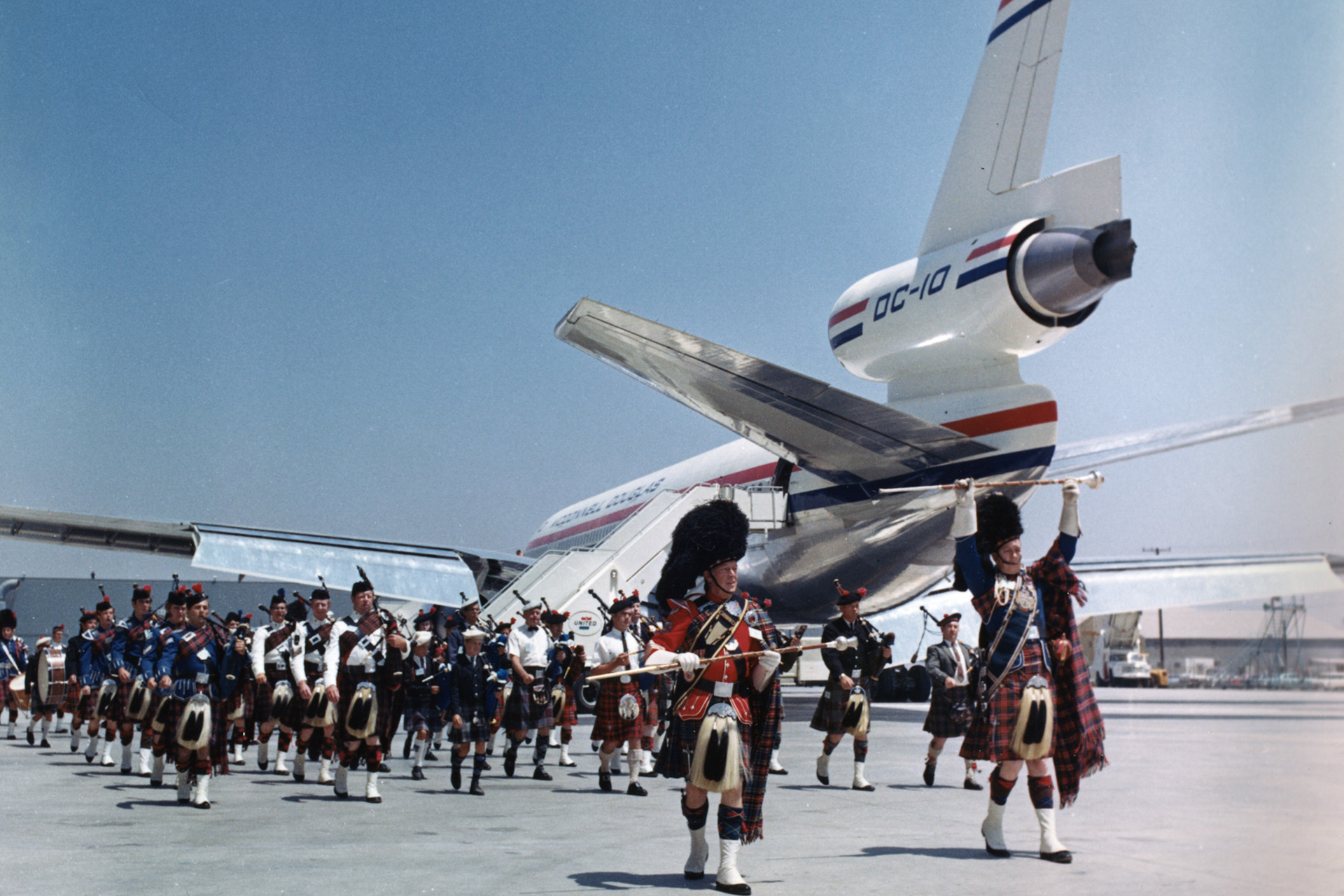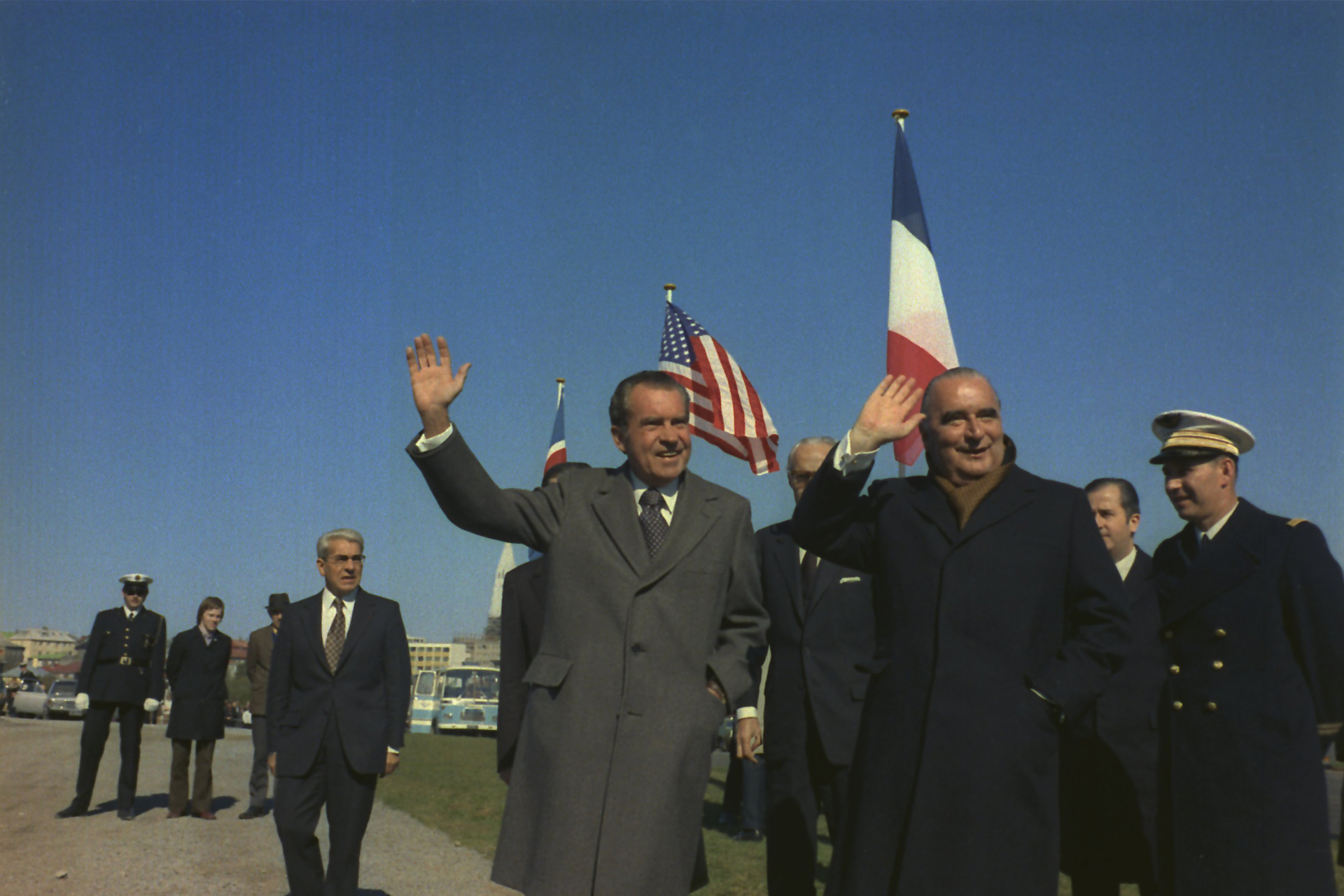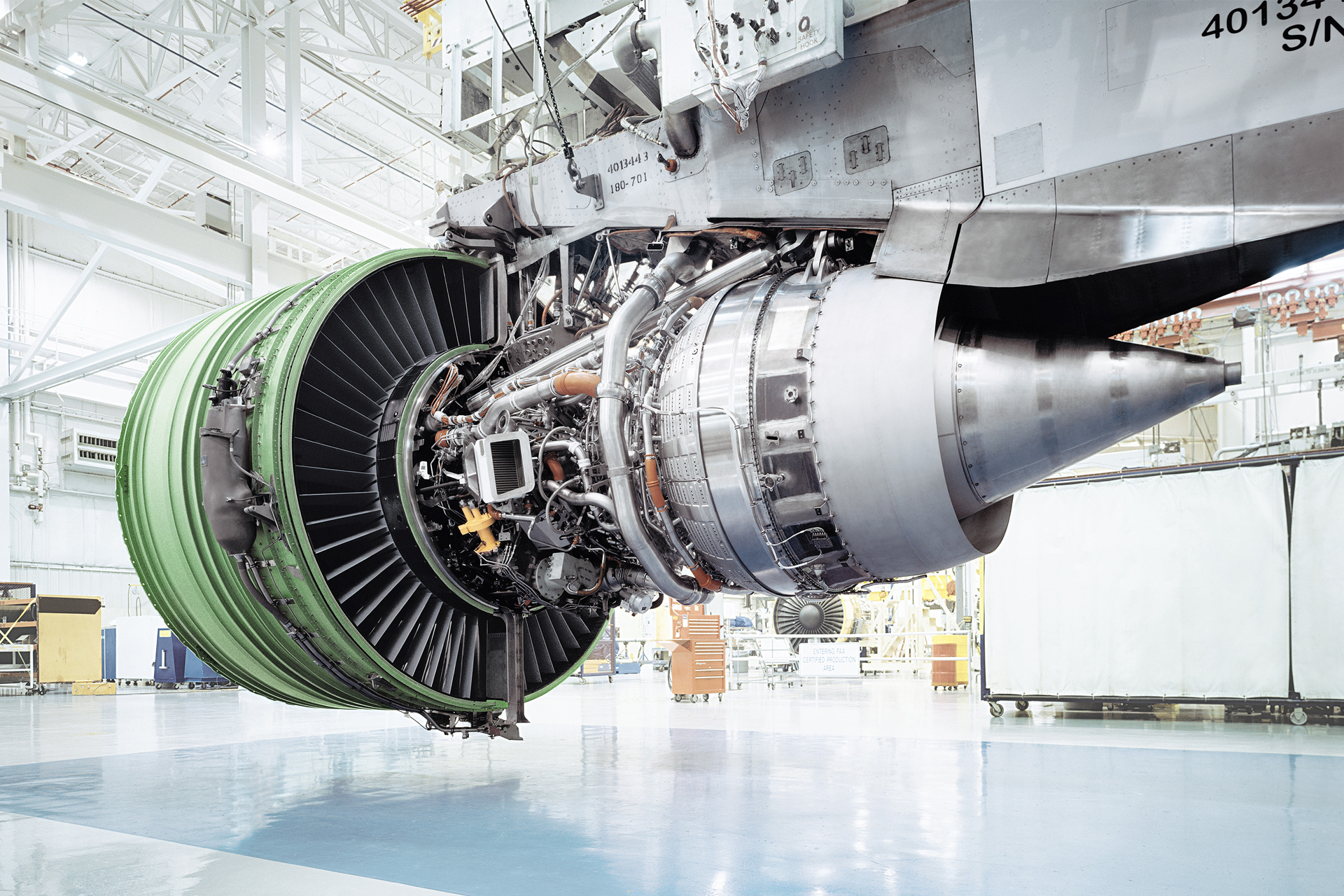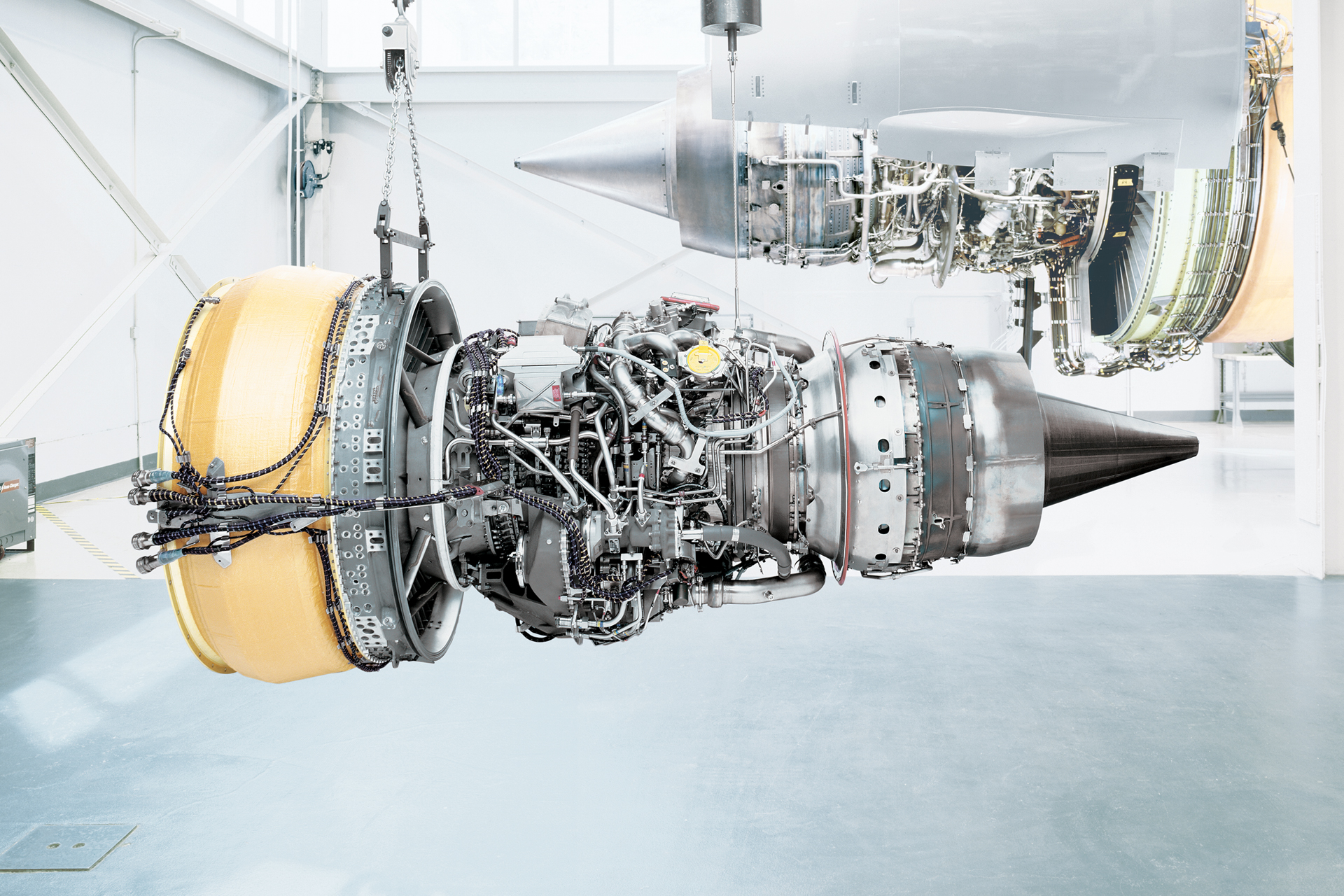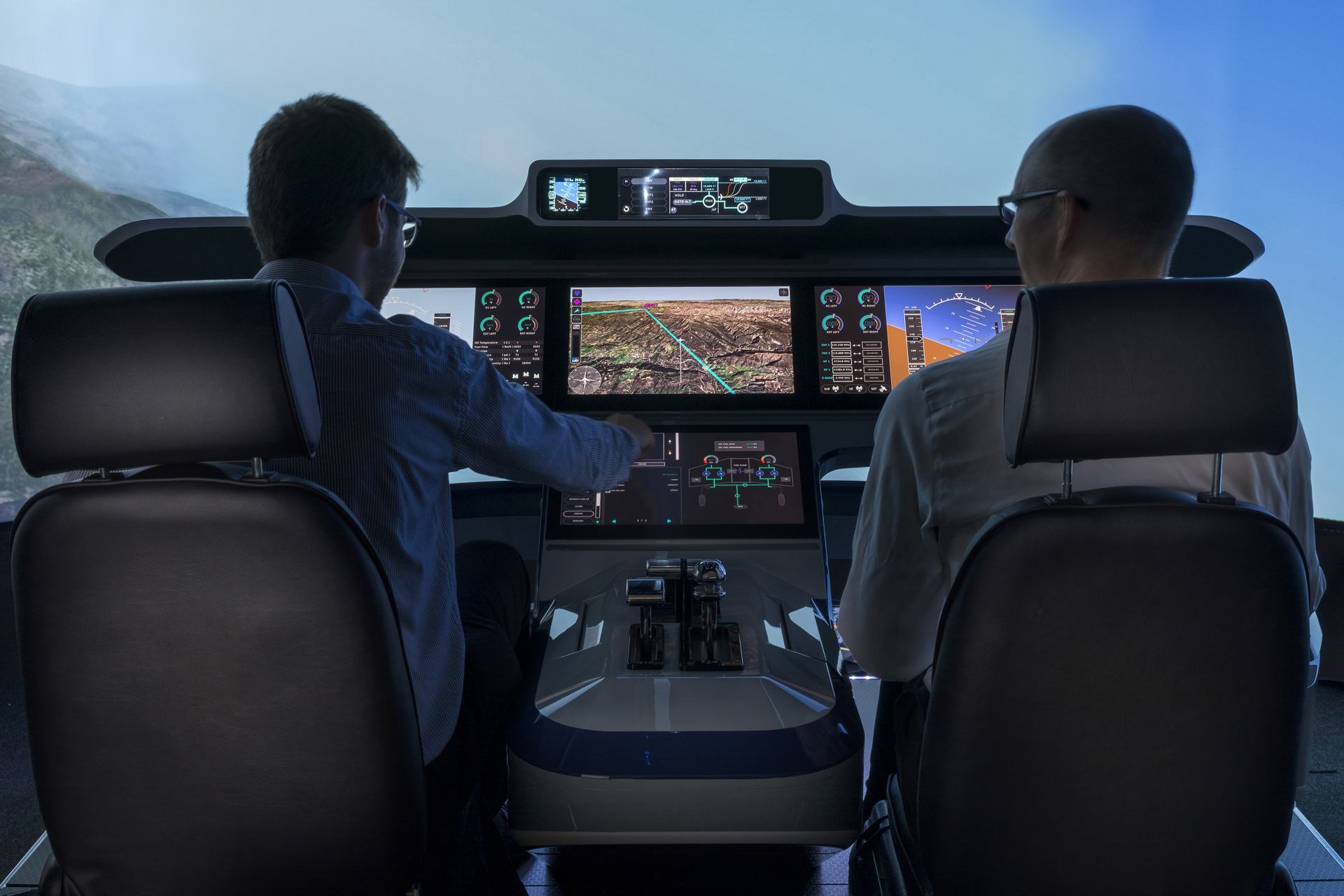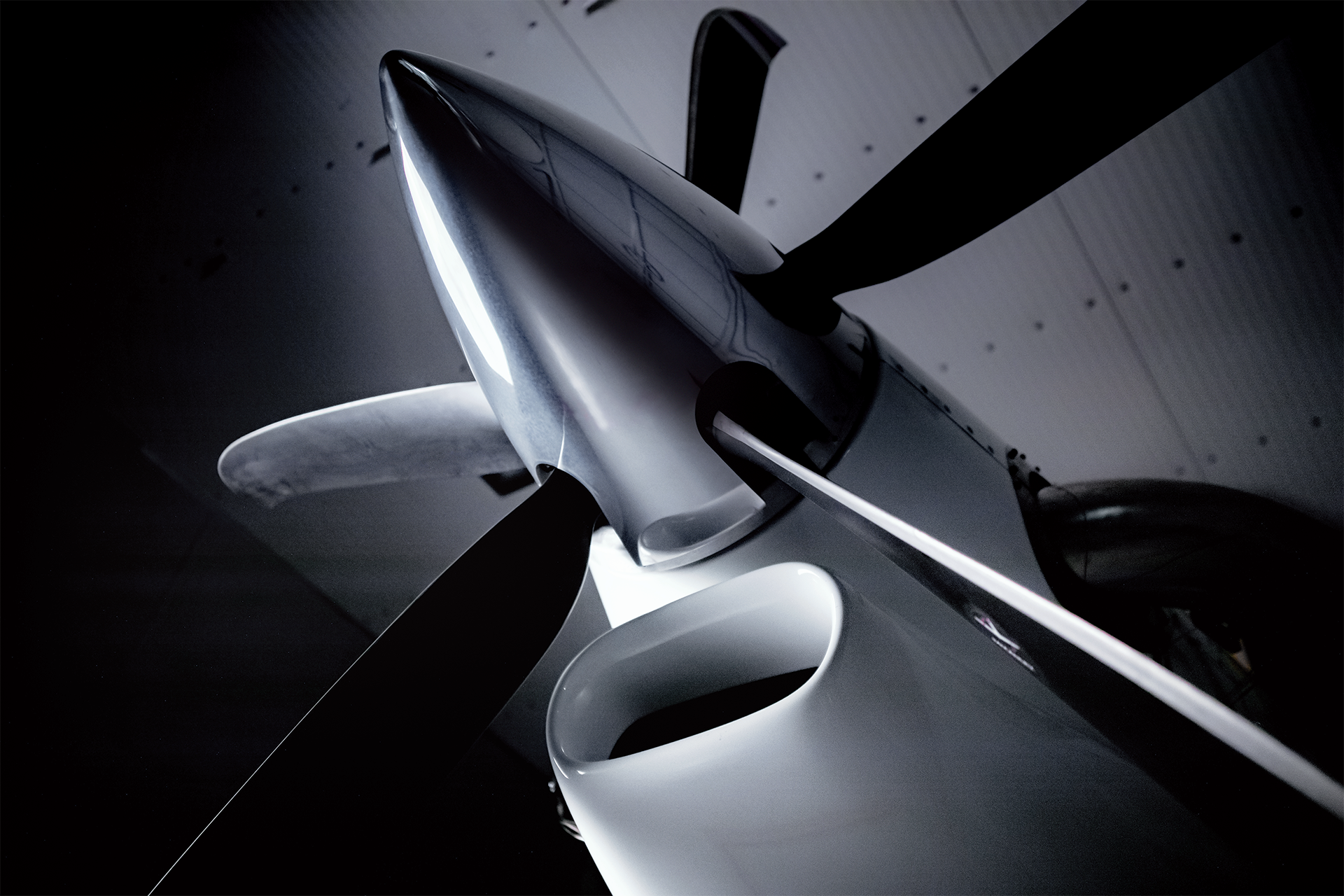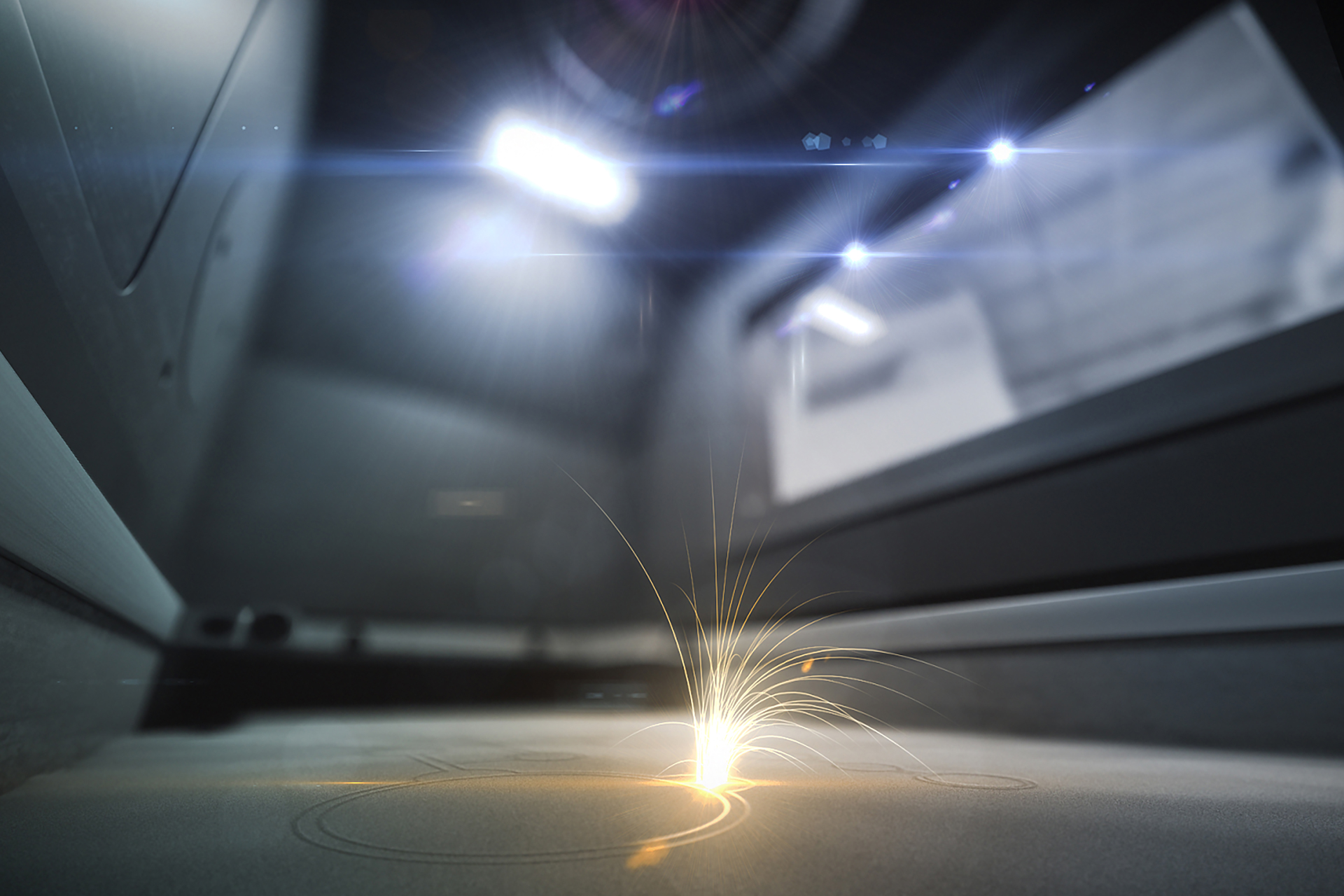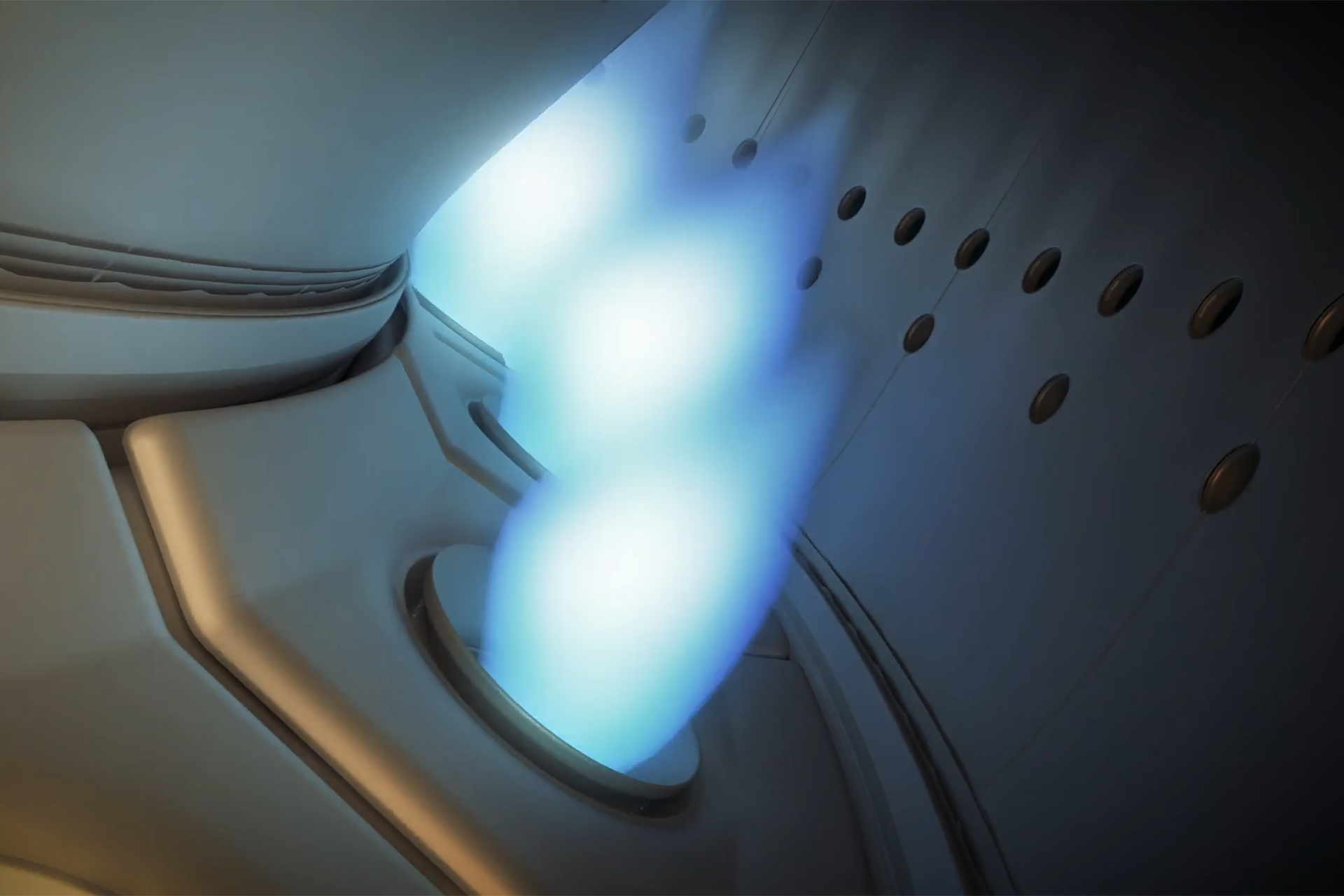Aerospace history
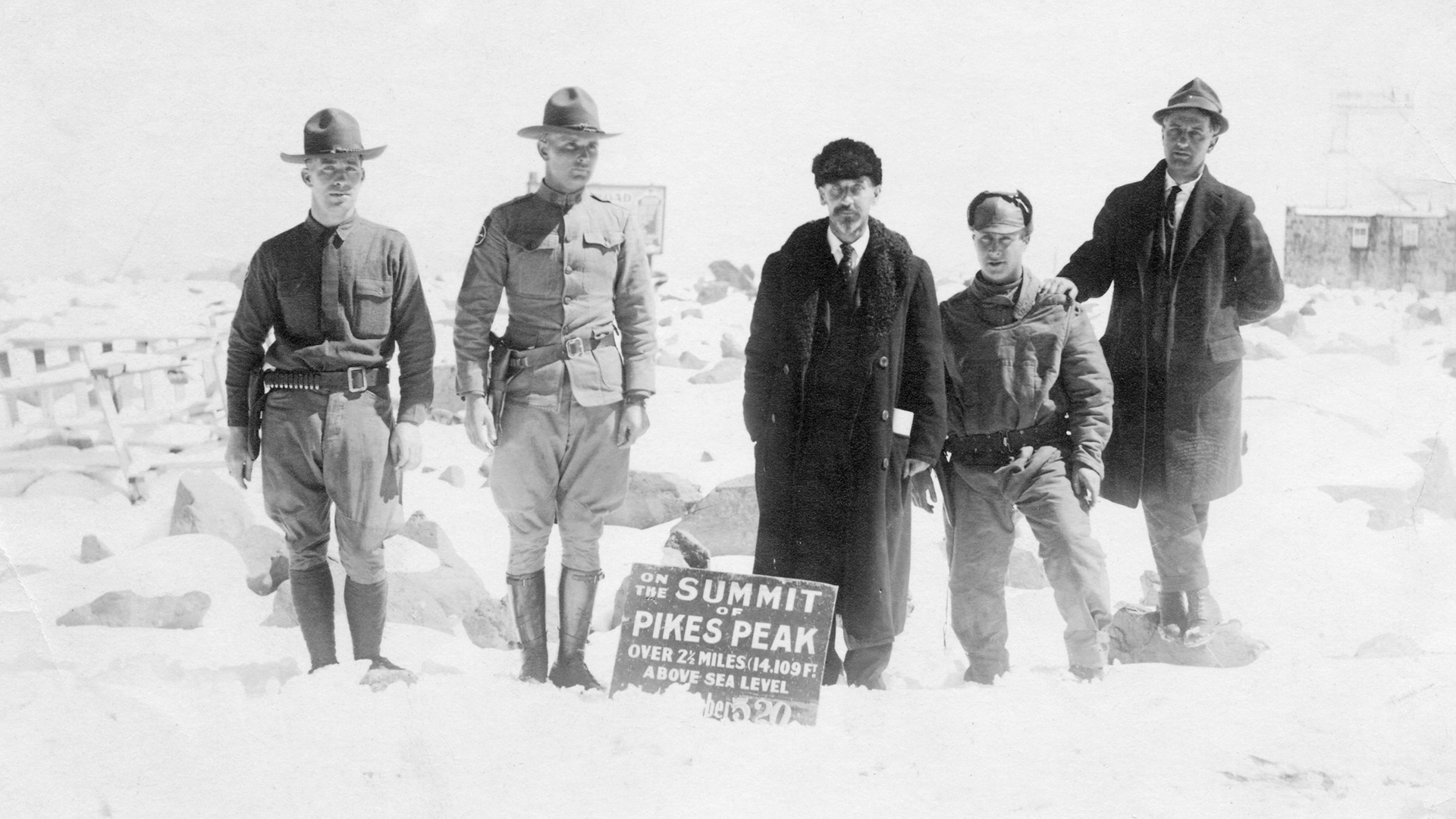
The future is our
When the United States entered World War I in 1917, the U.S. government searched for a company to develop the first airplane engine "booster" for the fledgling U.S. aviation industry. This booster, or turbosupercharger, installed on a piston engine, used the engine's exhaust gases to drive an air compressor to boost power at higher altitude.
GE accepted the challenge first, but another team also requested the chance to develop the turbosupercharger. Contracts were awarded in what was the first military aircraft engine competition in the U.S. Under wartime secrecy, both companies tested and developed various designs until the Army called for a test demonstration.
In the bitter atmosphere of Pikes Peak, 14,000 feet above sea level, GE demonstrated a 350-horsepower, turbosupercharged Liberty aircraft engine and entered the business of making airplanes fly higher, faster and with more efficiency than ever before. That mountaintop test of the first turbosupercharger landed GE's first aviation-related government contract and paved the way for GE to become a world leader in jet engines.
For more than two decades, GE produced turbosuperchargers that enabled aircraft, including many in service during World War II, to fly higher, with heavier payloads. The company's expertise in turbines and turbosuperchargers figured into the U.S. Army Air Force's decision to select GE to develop the nation's first jet engine.
Since then, the aircraft engines division of GE Aerospace has scored many firsts. Among them: America's first jet engine, the first turbojet engines to power flights at two and three times the speed of sound, and the world's first high bypass turbofan engine to enter service.
Today, GE Aerospace is a global provider of engines, systems, and services, with revenues exceeding $30 billion. As a leader in aviation technology, GE Aerospace continues to design, develop and manufacture jet engines, components and integrated systems for military, commercial and business and general aircraft as well as aero-derivative gas turbines for marine applications. In addition, GE Aerospace is the world's leading integrated engine maintenance resource.
Because principles and challenges in turbosuperchargers apply to gas turbines as well, GE was a logical choice to build America's first jet engine.
In 1941, the U.S. Army Air Corps picked GE's Lynn, Massachusetts, plant to build a jet engine based on the design of Britain's Sir Frank Whittle. Six months later, on April 18, 1942, GE engineers successfully ran the I-A engine.
In October 1942, at Muroc Dry Lake, California, two I-A engines powered the historic first flight of a Bell XP-59A Airacomet aircraft, launching the United States into the Jet Age. The thrust rating of the I-A was 1,250 pounds; the thrust rating of the GE90-115B is more than 90 times as great at 115,000 pounds.
The I-A engine incorporated a centrifugal-flow compressor, as did the increasingly more powerful engines developed by GE during the next two years, culminating in the J33 engine, which was rated at 4,000 pounds of thrust. The J33 powered the U.S. Army Air Corps' first operational jet fighter, the P-80 Shooting Star, to a world's speed record of 620 miles per hour in 1947. Before the end of that year, a GE J35 engine powered a Douglas D-558-1 Skystreak to a record breaking 650 miles per hour. The J35 was the first GE turbojet engine to incorporate an axial-flow compressor--the type of compressor used in all GE engines since then.
However, the Air Corps, concerned about disrupting supplies of turbosuperchargers, placed production of GE's jet engines with other manufacturers. GE then set about designing another. The resulting J47 put GE back in the business of building jet engines. But demand for the J47 to power almost all the new front-line military aircraft, particularly the F-86 Sabre Jet, meant the Lynn plant could not keep up. GE needed a second factory.
GE selected a federally owned plant near Cincinnati, Ohio, where Wright Aeronautical piston engines had been produced during World War II. GE formally opened the plant on February 28, 1949, with the second J47 production line, to complement the original line at Lynn. Later, the plant would be known as Evendale and would become GE Aerospace's world headquarters.
With the Korean War boosting demand, the J47 became the world's most produced gas turbine. More than 35,000 J47 engines were delivered by the end of the 1950s. That engine scored two major firsts: it was the first turbojet certified for civil use by the U.S. Civil Aeronautics Administration- and the first to use an electronically controlled afterburner to boost its thrust.
The war created a boom environment. Employment at GE's Evendale facility experienced a- ten-fold increase, from 1,200 to 12,000 people in 20 months, requiring a tripling of manufacturing space. In 1951, GE announced that the Evendale plant would be one of the world's truly great jet engine centers in peace and war. In 1954, the Evendale manufacturing complex, virtually empty just six years earlier, was designated as GE's production facility for large jet engines while its sister plant in Lynn, Massachusetts, focused on developing and producing small jet engines.
GE Aerospace’s military division is working on innovations today that will transform tomorrow’s missions. From the revolutionary Adaptive Cycle Engine (ACE), in conjunction with the Air Force Research Lab, to the T901 for the Army’s Improved Turbine Engine Program (ITEP), GE Aerospace’s next generation portfolio includes unprecedented speed, power, fuel efficiency and reduction in maintenance costs. These advancements will forever change the military’s approach to protecting freedom.
This ambition for building upon previous technology, knowledge and experience goes back to the Company’s first generation of engineers. GE rapidly grew its jet engines business thanks to the industrialization of the most produced combat engine, the J47, with more than 35,000 manufactured.
As the need for more power for the Century Series fighters, which would fly at more than twice the speed of sound, GE responded with one of the most important developments for the jet engine, the variable stator for its J79 turbojet engine. The movable stator vanes in the engine helped the compressor cope with the huge internal variations in airflow from takeoff to high supersonic speeds.
More than 17,000 J79s were built over 30 years, powering aircraft such as the F-104 Starfighter, F-4 Phantom II, RA-5C Vigilante, and B-58 Hustler. For the Convair 880/990 series airliner, the CJ805 derivative of the J79 engine marked GE's entry into the civil airline market.
Meanwhile, GE was busy with a new gas turbine to transform helicopter capability. The 800-horsepower T58 turboshaft engine powered a Sikorsky HSS-1F in the U.S.'s first turbine-powered helicopter flight. That engine, which first ran in the 1950s, was the precursor of Lynn's small engine product line.
The 1950s and 1960s saw further advances. The J93 was developed to power the world’s largest, highest flying, and fastest bomber, the US Air Force’s experimental XB-70 Valkyrie. Six 28,800 lb thrust turbojets propelled the 500,000 lb demonstrator to three times the speed sound at an altitude of 74,000 feet. Technologies pioneered in the J93 are used in today’s military and commercial engines.
A major success of the period was the Lynn-manufactured J85 turbojet engine. Contracted by the USAF to build a low-cost air-combat fighter, Northrop built the F-5 Freedom Fighter around the GE J85 engine. The F-5 soon became the standard air defense aircraft for more than 30 nations. The J85 powers the US Air Force T-38 Talon supersonic pilot trainer.
GE introduced the T64 free-turbine turboshaft/turboprop engine in 1964, featuring technical innovations such as corrosion resistant and high-temperature coatings that contributed to the development of very heavy lift helicopters. The T64 was used on the Sikorsky CH-53 Sea Stallion family of helicopters that serve the US Navy, U.S. Marine Corps and several international militaries.
When the U.S. Navy needed a durable and efficient engine to power the Lockheed S-3 Viking for carrier based anti-submarine warfare, GE responded with the TF34 high bypass engine. The TF34 was also selected by the U.S. Air Force to power the A-10 Thunderbolt II close air support aircraft.
Advances in compressor, combustor and turbine knowledge in the 1960s led to the decision to propose a more compact core engine with a single-stage turbine and only two bearing areas versus three, resulting in the GE F101 engine, selected for the U.S. Air Force's B-1 bomber.
In the early 1970s, the Army turned to GE for an improved turboshaft engine to power its new generation of helicopters. The result was the legendary T700. Capitalizing on the lessons of the Vietnam War, the T700 provided the Army exceptionally reliable power built using a revolutionary modular architecture. The modular T700 was designed for field maintainability to drive down costs and improve Army helicopter readiness rates. Over the ensuing decades, multiple advanced technology upgrades were introduced for the T700. Also, the T700-derived, CT7 turboshaft and turboprop engine family was introduced for the commercial market. More than 25,000 T700/CT7 engines have been delivered. Since their introduction more than 40 years ago, the T700 and CT7 variants continue to establish new applications as one of the among popular turboshaft and turboprop engine families in aviation history.
The role of GE military engines continued to grow during the defense buildup of the 1980s. In 1984, the USAF selected GE's highly reliable F110 engine, based on the F101 design, for the F-16C/D fighter aircraft, initiating "The Great Engine War"- an intense, competition between GE and rival Pratt & Whitney. The F110 now powers the majority of USAF F-16C/Ds. The F110 also powers F-16s worldwide, having been selected by Israel, Greece, Turkey, Egypt, Bahrain, United Arab Emirates, Chile and Oman. In addition, the F110 powers Japan's single-engine F-2 fighter and the export versions of the F-15 Eagle operated by Korea, Saudi Arabia and Singapore. From the late 1980s through 2006, the US Navy operated an upgraded version of the F-14 Tomcat with the F110 engine. A derivative of the F110, the F118, powers the U.S. Air Force B-2 stealth bomber and U-2S high altitude reconnaissance aircraft.
Also in the 1980s, the F404 engine for the F/A-18 Hornet entered production. The F404 is the world's most ubiquitous fighter engine, with more than 3,700 powering 10 aircraft types worldwide. These include the Boeing F/A-18 Hornet, Saab JAS 39 Gripen, Korea’s T-50, India’s Tejas Mark I and the Lockheed Martin F-117 stealth fighter prior to its retirement in 2008.
GE is positioned to be a world leader in military propulsion well into the 21st century. The F414, the turbofan engine for the F/A-18E/F Super Hornet front-line strike fighter and EA 18G Growler electronic attack aircraft, produces 22,000 pounds of thrust. It is also the engine of choice for the JAS 39E Gripen Next Generation and HAL Tejas Mark II. GE Aerospace has the capability to increase F414 durability and thrust by as much as 25 percent.
GE first received funding to begin developing a competitive engine for the Joint Strike Fighter (JSF) in 1996 and ultimately teamed with Rolls Royce for the full-scale development contract. The team successfully completed Short Take Off, Vertical Landing (STOVL) testing on an F136 engine at the GE testing facility at Peebles, Ohio in 2008. Extensive ground testing of the F136, designed for all variants of the JSF aircraft for the Air Force, Navy and Marine Corps, included the first use of ceramic matric composites in GE-designed components and paved the way for expanded use of these revolutionary materials in GE’s next generation commercial engines and military engines.
Due to US Government fiscal challenges and DoD budget cuts, Congress made the decision in 2011 to discontinue funding development of the F136 and the program was cancelled after about 80% completion.
Building on the strength of its design capabilities for high performance combat aircraft engines, GE successfully completed testing the world’s first adaptive, three-stream engine in 2014 through the Adaptive Versatile Engine Technology (ADVENT) program with the United States Air Force Research Lab.
By the next decade, the adaptive cycle (also called variable cycle) engine could revolutionize jet fighters. The variable cycle engine alternatives between a high-thrust mode for maximum power and a high efficiency mode for optimum fuel savings and greater aircraft range. In 2018, the USAF awarded to GE a $437 million contract to further advance adaptive-cycle engine technology, bolstering the company’s 11-year effort in this technology dating back to 2007.
GE’s next-generation military portfolio also includes the T901 turboshaft (downselected by the U.S. government in 2019) now under development, and also, the T408 turboshaft for heavy lift missions of the new Sikorsky CH-53 King Stallion for the U.S. Marine Corps. Capable of producing more than 7,500 shaft horsepower, the T408 combines breakthrough technologies, innovative cooling schemes and durability to deliver numerous mission-critical advantages in the world’s harshest operating environments.
The T901 is being designed as a replacement for the T700 engine powering existing Black Hawk and Apache helicopters through the U.S. Army’s Improved Turbine Engine Program (ITEP). Compared to the most advanced T700 engines in service, the T901 provides 25 percent better fuel economy, 35 percent lower acquisition and maintenance costs, 20 percent longer life and as much as 65 percent more power to weight.
GE Aerospace invests more than $1 billion each year in research and development, positioning the company to lead advancements in military propulsion for generations to come.
Building on the technology of the TF39 military engine, GE moved aggressively into the civil market in 1971 with a derivative engine, the CF6-6 high bypass turbofan engine, on the Douglas DC-10. The CF6 family grew to include the CF6-50, CF6-80A, CF6-80C2 and CF6-80E1. In the 1980s, the CF6 family of engines emerged as the most popular engines powering wide-body aircraft, including the Boeing 747 and 767, the Airbus A300, A310, A330 and the McDonnell Douglas MD-11.
The CF6, in service since 1971, continues to add to its impressive record of flight hours, more than any other commercial aircraft engine ever accumulated. To put that in perspective, it is the equivalent of one engine running 24 hours a day, 365 days a year for more than 26,000 years.
The CF6-80C2 engine, which entered service in 1985, has set new standards of reliability in commercial service and has been instrumental in the rise of GE as a leading supplier of large commercial engines.
Perhaps the greatest compliment afforded the CF6-80C2 was the U.S. government's selecting the engine to power the U.S. president's 747 aircraft, Air Force One.
In 1971, Safran Aircraft Engines (formerly Snecma) of France selected GE as a partner to develop a new turbofan engine in the 20,000 pound thrust class. Three years later, the 50/50 joint company – named CFM International – was formally established and would become one of the greatest success stories in aviation history.
This original engine collaboration combined Safran’s fan technology with core engine technology from GE’s F101 military engine. The GE/Safran collaboration was founded on a desire to gain a share of the short-to-medium-range aircraft market, dominated in the early 1970s by low bypass engines. CFM wanted to compete with the Pratt & Whitney JT8D engine then powering the Boeing 737-100/-200 and McDonnell Douglas DC-9 twinjets, as well as the Boeing 727 trijet.
CFM proved that patience is a virtue as the joint company did not receive its first order until 1979, when the CFM56-2 turbofan was selected to re-engine the DC-8 Series 60 aircraft, renamed the DC-8 Super 70s. Then the USAF selected the military version of the CFM56-2, designated the F108 in this application, to re-engine its fleet of KC-135 tanker aircraft to the KC 135R configuration. With these landmark orders, the CFM56 was on its way.
The original CFM56-2 would go on to power more than 550 commercial and military aircraft worldwide.
In a landmark 1981 decision, Boeing selected the CFM56-3 turbofan to power the popular Boeing 737-300/400/500 “Classic” series aircraft. Also in the 1980s, the CFM56-5 engine family was designed to power the highly popular Airbus Industrie A318, A319, A320, and A321. The CFM56-5C also powered the original four engine Airbus A340.
In the early 1990s, Boeing selected the CFM56-7 engine for the Next-Generation 737-600/-700/-800/-900 series. The CFM56-7 would experience an aggressive production run for more than 20 years.
CFM International has continued to advance jet engine propulsion. In 1995, the company made history when the first engine equipped with a double annular combustor (DAC), the CFM56-5B, entered commercial service with Swissair. The TECH56 technology program, launched in 1998, advanced propulsion for upgrades to existing engines and served as baseline technology for the next-generation CFM turbofan, ultimately called the LEAP.
In 2008, CFM International launched the LEAP engine to power new narrow-body aircraft on the horizon. This engine introduced several new technologies, including carbon-fiber front fan blades and the first ceramic matrix composite components in the hot section of a commercial jet engine.
By 2011, the LEAP engine was successfully launched on the Airbus A320 neo, the Boeing 737 MAX, and the COMAC C919. By 2018, the LEAP order backlog exceeded 15,000 engines. That represents seven years worth of engine production. Also in 2018, LEAP deliveries surpassed CFM56 deliveries.
FlightGlobal Ascend Aircraft Fleet Database has ranked the CFM56 family as the most popular commercial jet engine family in aviation history with more than 23,000 engines delivered. Into this new decade, the CFM International family of engines – including both the CFM56 and LEAP – will represent the most produced jet engines in jet propulsion history.
GE’s famed J47 fighter engine of the 1940s and 1950s, the most produced jet engine ever with more than 35,000 engines delivered, is now looking over its shoulder at the CFM fleet of CFM56 and LEAP engines.
Marine & Industrial Gas Turbines
As the world's leading manufacturer of aircraft gas turbines, it was a logical step for GE to expand its activities into the marine and industrial arenas. Thousands of GE aeroderivative gas turbine engines have been sold for marine and industrial use.
In 1959, GE introduced the LM1500, a derivative of the very successful J79. The LM1500 was initially installed aboard a hydrofoil ship.
In 1968, GE launched the LM2500, a nominal 20,000-shaft-horsepower gas turbine based on the TF39 engine. The LM2500 has become the mainstay of GE's current marine and industrial business, with more than fifty classes of ships in 24 world navies and several fast ferries. In the 1980s, GE introduced the LM1600, based on the F404 engine. During the 1990s, improved, lower-emission versions of the LM2500, LM1600, and LM6000 were introduced.
GE Industrial Aeroderivative Gas Turbines, part of GE Power Systems, has assumed responsibility for design, development and production of aeroderivative gas turbines for industrial applications. GE Industrial Aeroderivative Gas Turbines is headquartered at the Evendale plant, as is GE Marine Engines, which remains a part of GE Aerospace.
The world's most powerful engine
With great fanfare in the early 1990s, GE developed the GE90 turbofan engine to power the twin-engine Boeing 777. The baseline GE90 engine was certified on the aircraft in 1995. It became the world’s largest and most powerful jet engine, and the first commercial jet engine to operate with carbon-fiber composite front fan blades.
However, the GE90 family truly came into its own in July 1999 when The Boeing Company selected the GE90-115B derivative engine as the exclusive engine for its longer-range 777-200LR and -300ER aircraft. It was one of the most significant wins in GE Aerospace history.
The GE90-115B engine introduced the world's largest fan (128 inches), composite fan blades and the highest engine bypass ratio (9:1) to produce the greatest propulsive efficiency of any commercial transport engine of its day.
The GE90-115B, rated at 115,000 pounds of thrust, represented the successful culmination of GE's strategy to build a new centerline GE90 engine specifically for the Boeing 777 aircraft family. The GE90-115B powered 777-300ER successfully entered passenger service in 2004 and has become one of the most reliable high-thrust jet engines in history.
Then in 2013, building upon the GE90-115B success, GE launched the GE9X engine as the sole engine for the new Boeing 777X aircraft. In a thrust class of 105,000 pounds, the GE9X features a 134-inch fan diameter, exceeding the 128-inch fan of the GE90-115B. The GE9X fan-blade count has been reduced to 16, compared to 18 for the GEnx and 22 for the GE90-115B.
The GE9X features several ceramic matrix composite components in the engine hot section. The engine is expected to contribute half of the aircraft’s 20 percent fuel efficiency improvement over previous 777 models.
In 2019, GE announced that the GE9X became the most powerful commercial jet engine after reaching 134,300 pounds of thrust during ground testing at Peebles, Ohio. This broke the previous record held by the GE90-115B engine of 127,900 pounds (also during ground testing at Peebles) back in 2002.
By 2020, the GE9X had more than 700 engines on order for the Boeing 777X.
In the early 1990s, GE played a significant role in popularizing regional jets into the airline industry.
The story begins in the 1980s when GE developed the CF34 commercial turbofan derivative from the highly successful TF34 military engine for the Fairchild Republic A-10 and Lockheed S-3A.
GE’s CF34-3 engines first powered Bombardier CL601 and CL604 corporate aircraft. In 1992, the CF34-3 was introduced on the highly successful Bombardier 50-passenger CRJ100 and CRJ200 regional airliners. A revolution was underway.
In the late 1990s, GE developed the CF34-8 family of engines, which power the Bombardier CRJ700 and CRJ900 and the Embraer 170 and Embraer 175 regional airliners. Also, GE developed the CF34-10 family of engines, which power the Embraer 190 and Embraer 195 regional airliners.
In 2002, COMAC of China selected the CF34-10 engine to power the ARJ21 regional jet.
November 2008 marked the beginning of the flight test program for the GE-powered ARJ21 aircraft and thus the maiden flight of China’s first domestically developed regional jet aircraft. The ARJ21 entered service in 2016.
The inherently quiet CF34 has made regional jet travel more comfortable and more productive. Low noise also contributes to greater operational flexibility. GE remained committed to the CF34 and invested more than $1 billion in new technologies for the engine family between 2005 and 2015.
In 2017, GE celebrated 25 years powering regional jets with more than 6,500 CF34 engines delivered. GE-powered regional jets produced by Bombardier, Embraer, and COMAC operate in 130 countries with 12,000 daily passenger flights.
Powering the largest commercial airliner
The Engine Alliance, a 50/50 joint venture between GE and Pratt & Whitney, was formed in August 1996 to produce a new high-thrust turbofan for long-range aircraft.
The GP7200 was derived from two of the most successful wide-body engine programs ever – the GE90 and PW4000 families. Building on the GE90 core and the PW4000 low pressure system, the GP7200 would go on to deliver outstanding performance, reliability, environmental levels, and customer value.
In 2001, Air France launched the GP7200 on the new Airbus A380-800. Seven years later, in 2008, the GP7200 entered revenue service powering the Emirates' A380-800 aircraft.
Setting new standards for engine efficiency
With the 2004 selection of GE to power Boeing's new 787 Dreamliner, the company launched the GEnx to produce 55,000 to 70,000 pounds of thrust.
The GEnx replaced the CF6 engine family, a workhorse for commercial and military wide-body aircraft for more than 40 years. The GEnx engine would go on to meet or exceed Boeing’s aggressive performance targets for the twin-engine Dreamliner. The 787 carries 200 to 250 passengers up to 8,300 nautical miles and uses 20 percent less fuel than previous aircraft of comparable size.
The GEnx was also selected to power Boeing's four-engine 747-8. The first flight of both the 787 and 747-8 aircraft occurred in 2010.
A year later, a GEnx-powered 787 set a record for speed around the world with a total trip time of 42 hours and 27 minutes. There was no previous around-the-world speed record for this weight class. The GEnx was well on its way.
By 2020, more than 2,500 GEnx engines have been sold as the fastest-selling, high-thrust GE engine in history. The GEnx is the most reliable and utilized engine on the Boeing 787. The GEnx has the highest-pressure ratio compressor in commercial service today, enabling the best fuel efficiency for an engine in its thrust class. As a result, the GEnx powers the longest Dreamliner routes, such as the recording-breaking, non stop flight by Qantas from New York to Sydney.
For the past two decades, GE Aerospace has made significant strides in advancing aviation technology beyond jet propulsion.
In 2007, GE acquired Smiths Aerospace, a U.K.-based supplier of integrated systems for aircraft manufacturers and engine components. The acquisition broadened GE’s offerings to aviation customers by adding innovative flight management systems, electrical power management, mechanical actuation systems and airborne platform computing systems. This business segment was named GE Aerospace Systems.
In 2009, GE Aerospace Systems reached a milestone by supplying the Boeing 787 Dreamliner with aircraft systems from takeoff to touchdown, including the common core system and landing gear system, on the aircraft’s maiden flight test.
The former Smiths electrical power facilities in Vandalia, Ohio, and Cheltenham, England, also exposed GE to the tremendous business potential for electrical power and distribution for modern aircraft.
In order to establish a full systems engineering and modeling capability in-house for customers, GE Aerospace made two bold moves during 2010-2011. First, it established the Electrical Power Integrated Systems Research & Development Center (EPISCENTER) on the University of Dayton campus in Dayton, Ohio. Second, the company established a sister electrical power and distribution center in the U.K., the Electrical Power Integration Centre (EPIC) at the GE Aerospace Bishops Cleeve campus in Cheltenham.
These centers enabled GE to test complete aircraft electrical systems by drawing from the company’s electrical power and distribution modeling and simulation capabilities.
Progress soon accelerated. In 2015, GE won the contract for the Boeing 777X’s electrical loan management system, backup generator, and the backup converter. This represented GE’s first electrical-power generating system for a commercial jetliner after years providing power for military aircraft.
In 2016, GE successfully extracted power from jet engines to generate electricity for future aircraft requirements. With help from NASA and the USAF, GE demonstrated a “dual-spool” extraction of one megawatt of power from a F110 fighter engine by pulling 250 kilowatts from the engine’s high-pressure turbine and 750 kilowatts from the low-pressure turbine.
Also in 2016, GE Aerospace consolidated its growing digital services under a single business called GE Aerospace, Digital Solutions. Its broad menu of digital products has continued to gain traction with airlines worldwide, supported by a global network of digital customer collaboration centers. GE’s aggressive move into digital products was sparked largely by the 2012 acquisition of the small Austin Digital in Austin, Texas, which revealed to GE new ways to use flight data analysis to optimize customer flight operations.
Business & Personal Turboprops: From H80 to the Catalyst
In early 2008, GE Aerospace created a new organization dedicated to the business and general aviation market. Thus, a new journey begins.
That same year, GE acquired Walter Engines, a Czech Republic-based manufacturer of small turboprop engines. The acquisition broadened GE's offerings for aviation customers and enabled the company take an important first step in the market for small, turboprop aircraft.
Soon after, GE launched a new turboprop derivative engine, derived from the Walter M601 engine, called the GE H80 for the utility, agriculture and retrofit aircraft segments. Thrush Aircraft launched the H80 to power its Thrush 510G Aerial Applicator.
This marked the first application for the H80 engine and the first North American new engine installation based on the Walter M601 engine family. In 2010, the H80 engine successfully completed its first flight on the Thrush 510G aircraft.
The H80 turboprop became a critical first-step for GE. In 2015, GE unveiled the Catalyst turboprop engine for a new Textron Cessna airplane. The Catalyst design feeds upon GE’s broad technology portfolio. By incorporating 3D aerodynamic design from the GE9X program, the Catalyst has double the pressure ratio of turboprop in its class and can deliver far greater fuel efficiency and power.
The Catalyst engine also features the Electronic Engine and Propeller System, which was first introduced on the H80 turboprop family. The system governs engine and propeller pitch with a FADEC unit. The Catalyst’s single lever simplifies the pilot’s job and maximizes performance without overdriving the engine. The system governs engine and propeller pitch as a single system.
Small and large cabin business aviation
In 2004, GE and Honda formed a 50/50 joint venture, called GE Honda Aero Engines. The joint company integrated the resources of GE and Honda Aero, Inc., a Honda subsidiary established to manage its aviation engine business. The GE Honda HF120 engine was launched in 2006 and selected to power Honda Aircraft Company's advanced light HondaJet. The HF120 took its maiden flight in late 2010 and entered service in 2015.
In 2010, Bombardier selected GE Aerospace to provide the integrated powerplant system for the new Global 7000 and Global 8000 business jets, launching the development of a new business jet engine for GE, called the Passport engine.
The Passport engine further strengthens GE's presence in the ultra long-range, large cabin business aviation segment, which includes aircraft that can travel up to 7,900 nautical miles with eight passengers. The engine incorporates advanced technologies from both GE's commercial and military engines developed with the company's annual $1B investment in new technology research and development.
As the second decade of the new century approached, it became increasingly clear that GE Aerospace needed to dramatically expand and upgrade its manufacturing capabilities to meet a surging commercial engine backlog, and also, in order to introduce new technologies (such as advanced materials) into these engines.
By 2014, GE and its partner companies faced a backlog of more than 15,000 commercial engines. By 2020, the number of commercial jet engines was fast approaching an unprecedented 40,000 engines.
From 2010 to 2016, GE Aerospace invested $4.3 billion in the U.S. to create new factories and to expand existing sites, including $350 million to renovate the company’s world headquarters in Evendale, Ohio. Another $1.1 billion was invested in GE Aerospace’s network of international sites. Among the dramatic changes:
- Auburn Additive manufacturing: GE’s new Auburn, Alabama, facility focused on large-scale additive manufacturing with rows of additive machines are installed to produce thousands of fuel nozzle injectors for the LEAP engine each year.
- Lafayette engine assembly: Opened in 2016, the new engine assembly in Lafayette, Indiana, produces LEAP engines. The plant is also a designated LEAP maintenance and overhaul shop.
- Evendale CMC laboratory: The CMC Fastworks Laboratory in Evendale further integrates production of ceramic matrix composite (CMC) components.
- Asheville CMC manufacturing: In 2014, GE opened the Asheville, North Carolina, plant to mass-produce CMC components for commercial and military engines.
- Peebles expansion: GE’s historic Peebles Test Operation in rural Adams County, Ohio, has undergone two major expansions during this century. The complex now operates 11 engine test sites, including two large indoor sites.
- Huntsville CMC materials: In 2019, GE opened a unique production complex in Huntsville, Alabama, to produce highly proprietary materials used to create CMC components.
GE Aerospace enters its second century in a fabulous position to further push the boundaries of aviation. With more than 65,000 engines in service and fast growing, GE Aerospace and its partner companies have built the world’s largest operational fleet and established a firm business foundation.
GE’s innovative portfolio of new commercial engines introduced already for this century is extensive: the GEnx and GE9X families, the CFM LEAP family, the GE Honda HF120 and Passport business jet engines, and the Catalyst turboprop.
In the military arena, GE’s next-generation fighter jet engines and advanced turboshaft engines, such as the T901 and T408, are setting propulsion performance records while being greater capability to future aircraft systems.
Dramatic progress in real-time trend monitoring and flight data analysis will further benefit aircraft operators as GE better understands what the massive reams of digital flight data reveal about its engine fleet in service.
With more than 80 facilities, GE Aerospace will continue to operate on the world stage and advance aviation in every corner of the globe.
